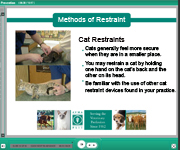| News for animal health professionals |  |
| Veterinary Medicine Update |  |  | | |  | - Bacteria with antibiotic-resistant gene detected in U.S. cat
A biological sample collected from a U.S. cat carried E. coli with the gene NDM-1, which renders the bacteria virtually impervious to antibiotics, marking the first time the gene has been found in bacteria from a pet. Bacteria carrying the gene were first noted in Sweden in a man who had become ill in India, but it has since been documented in numerous countries, including the U.S. Bacteria with this gene can survive in the gut without causing symptoms, thus spreading covertly and posing a serious threat to human health, scientists warn. Wired.com/Superbug blog (9/12)      - Tapeworms gaining ground in Canada and U.S.
Echinococcus multilocularis, a tapeworm carried by wild animals that infects some 18,200 people worldwide every year, is being found with increasing frequency in Northern Hemisphere coyotes, foxes and other wildlife, and that has public health officials concerned about zoonotic infections in humans and their companion animals. "It seems like there is a real route for coyotes to bring this into the cities and into dog parks," says veterinarian Emily Jenkins, an assistant professor at the University of Saskatchewan. Although experts say the risk is relatively low, it may be increasing as humans and animals increasingly interact, and a European strain may be more infectious to humans. CTV.ca (Canada)/The Canadian Press (9/13)      - Pittsburgh Zoo marks historic black rhino birth
After 15 months of waiting, Pittsburgh Zoo officials said the facility's female black rhinoceros, Azizi, gave birth to a female baby, marking the zoo's first black rhino birth in 47 years. With only 4,800 animals left in the wild, every captive black rhino birth is a landmark occasion. Zoo veterinarians monitored the birth and say the calf appears to be healthy. Pittsburgh Post-Gazette (9/12)       | Do You Need Help Providing Safety Training at Your Practice?
The PLIT offers a free web-based employee training tool at www.avmaplit.com/safety. With the seven newly redesigned modules, staff members can view veterinary-specific training programs while practice managers track staff progress. The test results also provide you with written documentation. Take advantage of this resource today! Click here for the FREE web-based employee training tool. | |
| Animal News |  |  | | - Veterinarian catches zoonotic illness from feathered patient
Veterinarians deal with numerous safety concerns during their daily work, not the least of which is the zoonotic illnesses such as ringworm carried by their patients, notes veterinarian John Kaya. On one occasion, Dr. Kaya contracted chlamydia psittaci, or psittacosis, after a bird sneezed on him during an examination. Dr. Kaya was successfully treated with antibiotics, but the case is a reminder that people who interact with animals must take care to minimize exposure to zoonotic diseases. MidWeek (Kaneohe, Hawaii)/MidWeek Kauai (9/12)      - Tips to maintain a healthy horse
Horses are excellent companions, but they have special needs that require an emotional and financial commitment, according to veterinarian Tricia Pugh, who shares 10 tips for protecting equine health. An enriching and safe environment, proper nutrition and adequate exercise, along with regular veterinary care, are important aspects of maintaining a horse's health, writes Dr. Pugh. The Press-News (Minerva, Ohio) (9/12)      - New York City's lights obscure, confuse migrating birds
Cornell University ornithologist Andrew Farnsworth and his colleagues marked the southern migration of millions of birds by watching them as they passed through the powerful beams of light emanating from New York City landmarks including the Empire State Building and the Tribute in Light. Birds use celestial navigation, the Earth's magnetic field and sight to find their way, but the bright lights can confuse them. "They're getting their sensory clues to migrate short-circuited by the light," said Farnsworth. The Wall Street Journal (9/12)       | Fly a lot? Earn 3X rewards points on airline purchases with The Business Gold Rewards Card from American Express OPEN. Designed to earn Membership Rewards® points faster:
• 3X points on airfare
• 2X points on advertising, gas, and shipping
• 1X points on everything else
• Limited Time Offer: 50K bonus points when you spend $5K in your first 3 months of Card membership†
LEARN MORE AND APPLY †Terms & Restrictions Apply. |
  - 3 tips for improving your accounting skills
Practicing proper accounting is important for keeping the IRS happy and making sure you maintain good relationships with your vendors, writes Rieva Lesonsky. You can get better at accounting by taking a class and getting accounting software. You should also set a schedule for completing important accounting activities, she advises. SCORE Small Business Success Blog (9/11)       | NEW WHITE PAPER: The CMO Guide to Integrated Marketing
ROI tools provide powerful decision-making support for strategic and tactical planning to drive better performance and profitability. While many companies have made progress, CMOs know there is more work to be done. Learn how to use an integrated marketing solution that delivers both effectiveness and efficiency in this FREE white paper from Aprimo. |

- Podcast: USDA's expanded E. coli testing
In June 2012, the USDA expanded its testing process for finding E. coli in raw beef. Now there are more strains they'll be looking for, in addition to the O157:H7 strain that it has been testing for since 1994. So what led to this change, and what does it mean for consumers? In AVMA's latest Chew on This podcast, Dr. Daniel Engeljohn from the USDA's Food Safety and Inspection Service talks about USDA's expanded E. coli testing. Listen to the podcast.     
 | The AVMA Veterinary Career Center (VCC) has the candidates and jobs you need to Find the Right Fit for your veterinary, veterinary technician, veterinary hospital manager and other team position needs. Come to www.avma.org/vcc to get started. | | SmartQuote |  |  | |  | Much may be done in those little shreds and patches of time which every day produces, and which many men throw away."
--Charles Caleb Colton,
British cleric and writer      |
| | | The news summaries appearing in Animal Health SmartBrief are based on original information from news organizations and are produced by SmartBrief, Inc., an independent e-mail newsletter publisher. The AVMA is not responsible for the content of sites that are external to the AVMA. Linking to a website does not constitute an endorsement by the AVMA of the site or the information presented on the site. Questions and comments should be directed to SmartBrief at avma@smartbrief.com. | This SmartBrief was created for jmabs1@gmail.com
| Advertise | | Account Director: Aaron Kern 202-407-7866 | | | | | | Read more at SmartBrief.com | | A powerful website for SmartBrief readers including: | | | | | | | | | | Recent Animal Health SmartBrief Issues: - Wednesday, September 12, 2012
- Tuesday, September 11, 2012
- Monday, September 10, 2012
- Friday, September 07, 2012
- Thursday, September 06, 2012
| | | Lead Editor: Melissa Turner
Sales Account Director: Sam Fuchs
Mailing Address:
SmartBrief, Inc.®, 555 11th ST NW, Suite 600, Washington, DC 20004 | | | | | | © 1999-2012 SmartBrief, Inc.® Legal Information |
|


No comments:
Post a Comment